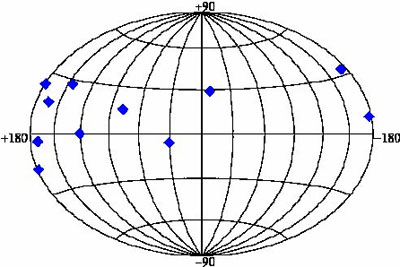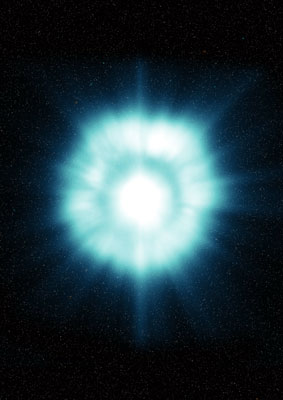[/caption]
Gamma-ray bursts (GRBs) are powerful blasts of energy that flash across the Universe. For a brief time, they are the brightest objects in the gamma-ray sky. Astronomers estimate that about 1,400 GRBs per year occur but because no one knows when and where they are going to appear, only a part of them happen to be detected. ESA’s Integral gamma-ray observatory detects about 10 GRBs a year, and those are of the big burst variety. But the spacecraft has observed several low-luminosity gamma-ray bursts, confirming the existence of an entire population of weaker bursts that have hardly been noticed so far. These aren’t just bursts from far away, but just weak bursts that are relatively close by. And astronomers are beginning to think these weak or faint variety of GRBs might be the most common.
When studying Integral’s gamma-ray burst data, Prof. Lorraine Hanlon from the School of Physics, University College Dublin, Ireland, and her colleagues, realized that some of the faintest bursts have distinctive gamma-ray emissions, and also present faint afterglows in the lower-energy X-ray and visible wavelengths.
Since, in general, GRBs are colossal explosions of energy triggered by the collision of very massive and compact objects such as neutron stars or black holes, or by the explosion of incredibly powerful supernovae, or hypernovae, one may think that these bursts are perceived as faint just because they take place very far away from us, in the remote corners of the Universe.
However, Prof. Hanlon and colleagues noticed that these faint bursts, just at the sensitivity threshold of IBIS, seem to originate in our cosmic neighborhood, within the nearby clusters of galaxies.

“If the bursts we have studied are so ‘close’ in cosmological terms, it means that they are faint from the beginning,” says Hanlon. “From this we can deduce that the processes triggering them could be less energetic than those generating the more powerful bursts we are more used to observing.”
The study team suggests that the faint bursts may be generated by the collapse of a massive star that does not present the characteristics of a supernova, or by the merger of two white dwarfs (small and dense stars about the size of Earth), or by the merger of a white dwarf with a neutron star or a black hole.
“Past observations had already hinted the existence of faint GRBs, and thanks to Integral’s sensitivity we can now say that an entire population of them exist,” added Hanlon. “Actually, their rate may even be higher than that of the most luminous GRBs but, just because they are weaker, we may be only able to see those which are relatively close by.”
“More Integral observations in the coming years will definitively help us understand the phenomenon of faint GRBs, and to explore the nature of this newly observed population,” she concluded.
Source: ESA


Little Gamma-Ray Bursts? Can I call them Gemma-Ray Bursts? Sounds cuter 🙂
Jeez, they actually made a press release out of this? I didn’t find their results very conclusive… Also, their paper is riddled with small errors.
I’m curious as to whether these faint GRBs are intrinsically low luminosity events or if their faintness may be ascribed to a ‘beaming effect’ where the GRB jets are not precisely aimed at the Earth? Also, have any of these events been traced directly to a galaxy in a nearby galaxy cluster, and if so, have any been detected in any other wavelengths. While these events may be detected near the supergalactic plane, might this not be due to a selection effect of the observations themselves. In what types of galaxies are these events observed. While I haven’t read the published paper, it seems the press release is short on details and I would be cautious about ascribing the origins of these events until more data is available.
Let us enjoy this mystery and we will find out something new.
Hmm . . . maybe GRBs are residual bursts of energy resulting from mini-big bang birthing sites of all matter we see. Maybe the classic ‘big bang’ isn’t so big after all and is still in progress. GRBs could simply be a signature of new matter violently exploding into existance.
Ok John, in the spirit of enjoying a good mystery (and before too much data constrains our speculation), I like the idea of quark stars settling slowly to some limiting and critical explosion point, where the basic components of matter (some fundamental ultimatonic Planck-scale oscillator) are brought [almost] into contact. The mother of all exclusion principles then kicks in, and the [fully] degenerate matter in this dark island (i.e. not black hole) is [fully] unzipped.
The measurable tail end of this event would be a squirting of E.M. (gamma, x), but most of the commotion would be among the pre-photonic ultimatonic dark matter particle… our Planck-scale oscillator.
Great fun, until constrained by too much good data.
@Nigel, I’m all for enjoying a good mystery and for having some fun speculating on the nature of the universe, but I can also have a lot of fun interpreting “too much good data”. BTW, exactly how much good data is too much? 🙂
The paper referenced in the above article can be found at arXiv:0803.1821v2 authored by S Foley et al. The paper mentions observations of several Xray afterglows and a few optical & near-IR afterglows, one appearing in the galaxy cluster Abell 1651, but mentions no GRBs linked to individual galaxies. It is suggested that the faint GRBs may be located in intergalactic space between galaxies in clusters (how convenient). The authors also consider that some of these faint GRBs may be cloaked by dense clouds of gas & dust, thus negating their claim of these being intrinsically ‘faint’ GRBs. Overall, their argument for a new class of faint GRBs seems rather premature, IMHO.
Anyone interested in a simple classical hypothetical mechanism for GRBs can send me an email at [email protected] and I will send him/her a short paper